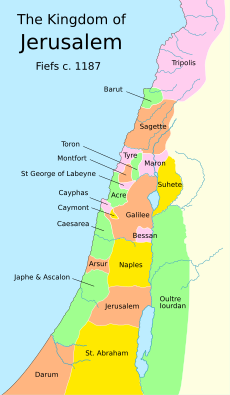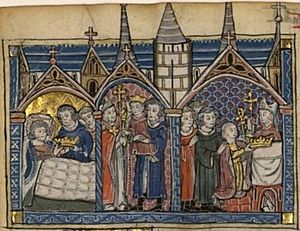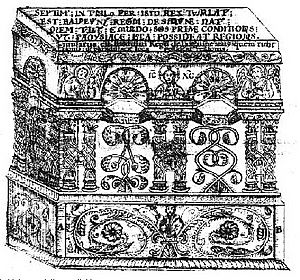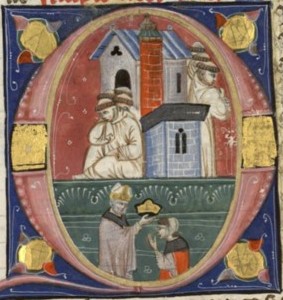Sibylla, Queen of Jerusalem facts for kids
Quick facts for kids Sibylla |
|
|---|---|

Detail of a 13th-century miniature
|
|
| Queen of Jerusalem | |
| Reign | 1186–1190 |
| Coronation | 1186 |
| Predecessor | Baldwin V |
| Successor | Isabella I |
| Born | c. 1159 |
| Died | 25 July 1190 Acre |
| Spouse | William Longsword of Montferrat Guy of Lusignan |
| Issue | Baldwin V of Jerusalem |
| House | House of Anjou |
| Father | Amalric of Jerusalem |
| Mother | Agnes of Courtenay |
Sibylla (born around 1159 – died 25 July 1190) was the Queen of Jerusalem from 1186 to 1190. She ruled alongside her husband, Guy of Lusignan. Sibylla was very loyal to Guy, even though many powerful nobles in the Kingdom of Jerusalem did not like him.
Sibylla was the oldest daughter of King Amalric and his first wife, Agnes of Courtenay. Her father died in 1174. This made her the person most likely to inherit the throne after her younger brother, King Baldwin IV. When it became clear that Baldwin, who was 13, had leprosy, finding a husband for Sibylla became very important.
In 1176, Sibylla married William Longsword of Montferrat. But William died in 1177, leaving her pregnant and in charge of the County of Jaffa and Ascalon.
After giving birth to her son, Baldwin, Sibylla started to be included in official public events with her brother. This showed that she was next in line for the throne. In 1180, her brother arranged for her to marry Guy of Lusignan. This marriage caused a big split among the nobles.
By 1183, King Baldwin IV was very sick and could no longer lead. He also did not trust Guy's leadership skills. To stop Guy from becoming king, Baldwin had Sibylla's young son crowned as co-king. He also tried to separate Sibylla from Guy, but she refused to leave her husband.
King Baldwin IV died in 1185. He chose Count Raymond III of Tripoli to rule as regent for Baldwin V, instead of Sibylla or Guy. The young King Baldwin V died the next year. Sibylla quickly moved to claim the throne, even though Raymond also wanted power. She agreed to set Guy aside, but only if she could choose her next husband. At her coronation in September 1186, she surprised everyone by choosing Guy again and crowning him herself.
In 1187, Saladin, a powerful Muslim leader, took advantage of the disagreements in the kingdom. He invaded and conquered most of the Kingdom of Jerusalem, leaving only the city of Tyre. Sibylla visited her husband, who had been captured by Saladin after the important Battle of Hattin. She managed to get Saladin to release Guy. Sibylla died in 1190, along with her daughters, from a sickness outside Acre while Guy was trying to capture the city.
Contents
Early Life and Education
Sibylla was the older of two children born to Amalric of Jerusalem, who was the count of Jaffa and Ascalon, and his first wife, Agnes of Courtenay. She was born between 1157 and 1161. Her younger brother, Baldwin, was born in 1161.
Sibylla's family were French-speaking Catholics from Western Europe. They were part of the ruling class in the Kingdom of Jerusalem. Sibylla was named after her father's half-sister, Sibylla of Anjou.
In 1163, Sibylla's uncle, King Baldwin III of Jerusalem, died. Her father, Amalric, became king. To become king, Amalric had to agree to end his marriage to Agnes. But he made sure that his children with Agnes, Sibylla and Baldwin, were still considered legitimate.
Sibylla was educated at the Convent of Saint Lazarus near Jerusalem. This was a common practice for noble girls. She lived with her great-aunt, Abbess Ioveta of Bethany. Because of this, Sibylla did not spend much time with her mother or brother.
King Amalric worried that he might die young, like his brother and father. If he did, his son, Baldwin, would be too young to rule. So, in 1169, Amalric sent the archbishop of Tyre to Europe to find a husband for Sibylla. The chosen man had to be older, high-ranking, and experienced in government. Amalric chose Count Stephen I of Sancerre. Stephen was related to the French and English royal families. He came to Jerusalem in 1171. At this time, Sibylla's brother was suspected of having leprosy, a serious illness that would prevent him from marrying and having children. So, Amalric might have seen Sibylla and Stephen as future rulers. However, Stephen refused the marriage for unknown reasons.
Becoming Heir to the Throne
King Amalric died in July 1174. He had a stomach illness. The High Court, a group of important nobles, met to decide who would be the next ruler. Sibylla's brother, Baldwin, was 13. He would have been the clear choice, but people worried about his leprosy. The only other serious option was Sibylla, who was about 15.
Women had ruled before in Jerusalem, like Sibylla's grandmother, Queen Melisende. But Sibylla was young, had no experience ruling, and was not married. There was no suitable single man in the kingdom for her to marry. Marrying a local noble could also cause arguments among other nobles. So, a husband had to be found from another country, but that would take too long. Because of this, Baldwin IV was chosen as king. The plan was to find a husband for Sibylla later, so she could take over if Baldwin's illness became too severe.
First Marriage
Count Raymond III of Tripoli became the regent, or temporary ruler, for the young King Baldwin. Raymond was the king's closest male relative. He allowed Sibylla and Baldwin's mother, Agnes, to return to the royal court. Sibylla and Baldwin became very close to their mother in the following years.
Baldwin's health quickly got worse, and it was clear he had leprosy. So, a husband for Sibylla was urgently needed. Raymond and the High Court chose William Longsword of Montferrat. William was the son of a powerful marquis and a cousin of both the Holy Roman Emperor and the King of France.
William arrived in Jerusalem in October 1176. By then, some nobles were less enthusiastic about him. This was probably because the Emperor had faced military problems in Europe. But the marriage had to happen. If Sibylla were rejected again, it would be very hard for her to find another husband. Sibylla and William married in November. He was given the County of Jaffa and Ascalon. Sibylla became a countess, a special title, like her mother. King Baldwin might have offered to give up his throne to William, but William likely refused because he knew he did not have enough support from the nobles.
Becoming Countess
Around April 1177, shortly after Sibylla became pregnant, William became very ill. He died in June. Sibylla was now the countess of Jaffa and Ascalon in her own right.
Soon after, Sibylla's cousin, Count Philip I of Flanders, arrived in Jerusalem. King Baldwin offered him the regency, but Philip refused. Philip wanted to arrange marriages for Sibylla and her half-sister Isabella. The High Court said that Sibylla needed a year to mourn her husband, especially since she was pregnant. Philip and the High Court disagreed on who should choose Sibylla's next husband. Baldwin of Ibelin, a powerful lord, hoped to marry Sibylla.
Sibylla gave birth to a son, named Baldwin, in the winter of 1177–78. Her mourning period ended in June 1178. It was time to find a new husband. Baldwin of Ibelin's offer was rejected. His brother, Balian of Ibelin, was allowed to marry Queen Maria, Sibylla's stepmother.
From July 1, 1178, Sibylla began to be included in public acts with her brother, King Baldwin. This was a way to show that she was officially the person next in line to the throne.
The High Court agreed that Sibylla should marry Duke Hugh III of Burgundy. King Baldwin needed a brother-in-law so badly that he wrote to the King of France, asking him to choose someone else if Hugh refused. Hugh planned to sail to the East in early 1180. A group of crusaders from France arrived in July 1179. They hoped to be there for Sibylla and Hugh's coronation.
Second Marriage
Things changed unexpectedly in early 1180. Hugh of Burgundy could not leave France because of conflicts there.
Historians have different accounts of what happened next. Some say Sibylla promised to marry Baldwin of Ibelin, but her mother convinced her to marry Guy of Lusignan instead. However, other historians believe this account is biased.
Another account says that Count Raymond III of Tripoli and Prince Bohemond III of Antioch were planning to take power from King Baldwin. They wanted to force the king to let Sibylla marry Baldwin of Ibelin and then make the king step down. King Baldwin stopped their plan by arranging Sibylla's marriage to Guy. Baldwin of Ibelin had never been approved by Sibylla's brother, possibly because his family had only recently become powerful nobles. Also, Saladin knew about Raymond and Bohemond's plan. He demanded a very high ransom for Baldwin of Ibelin, making him an undesirable choice for a future king.
From 1180, Sibylla and Guy ruled Jaffa and Ascalon together. They had four daughters. Their marriage caused a deep division among the nobles. Some supported Guy, including Sibylla, the king, their mother Agnes, and other powerful lords. Others opposed Guy, including Sibylla's relatives like Bohemond of Antioch and Raymond of Tripoli, and the Ibelin brothers.
To prevent the opposing group from choosing a different ruler, King Baldwin followed his mother's advice. In October 1180, he arranged for his half-sister Isabella, Maria's daughter, to marry Humphrey IV of Toron. From March 1181, both Sibylla and Guy were included in King Baldwin's public acts, showing their importance.
| Sibylla's family, including Guy and his supporters (blue) and Guy's opponents (red) | ||||||||||||||||||||||||||||||||||||||||||||||||||||||||||||||||||||||||||||||||||||||||||||||||||||||||||||||||||||||||||||||||||||||||||||||||||||||||||||||||||||||||||||||||||||||||||||||||||||||||||||||||||||||||||||||||||||||||||||||||||||||||||||||||||||||||||||||||||||||||||||||||||||||||||||||||||||||||||||||||||||||||||||||||||||||||||||||||||||||||||||||||||||||||||||||||||||||||||||||||||||||||||||||||||||||||||||||||||||||||||||||||||||||||||||||||||||||||||||||||||||||||||||||||||||||||||||||||||||||||||||||||||||||||||||||||||||||||||||||||||||||||||||||||||||||||||||||||||||||||||||||||||||||||||||||||||||||||||||||||||||||||||||||||||||||||||||||||||||||||||||||||||||||||||||||||||||||||||||||||||||||||||||||||||||||||||||||||||||||||||||||||||||||||||||||||||||||||||||||||||||||||||||||||||||||||||||||||||||||||||||||||||||||||||||||||||||||||||||||||||||||
|---|---|---|---|---|---|---|---|---|---|---|---|---|---|---|---|---|---|---|---|---|---|---|---|---|---|---|---|---|---|---|---|---|---|---|---|---|---|---|---|---|---|---|---|---|---|---|---|---|---|---|---|---|---|---|---|---|---|---|---|---|---|---|---|---|---|---|---|---|---|---|---|---|---|---|---|---|---|---|---|---|---|---|---|---|---|---|---|---|---|---|---|---|---|---|---|---|---|---|---|---|---|---|---|---|---|---|---|---|---|---|---|---|---|---|---|---|---|---|---|---|---|---|---|---|---|---|---|---|---|---|---|---|---|---|---|---|---|---|---|---|---|---|---|---|---|---|---|---|---|---|---|---|---|---|---|---|---|---|---|---|---|---|---|---|---|---|---|---|---|---|---|---|---|---|---|---|---|---|---|---|---|---|---|---|---|---|---|---|---|---|---|---|---|---|---|---|---|---|---|---|---|---|---|---|---|---|---|---|---|---|---|---|---|---|---|---|---|---|---|---|---|---|---|---|---|---|---|---|---|---|---|---|---|---|---|---|---|---|---|---|---|---|---|---|---|---|---|---|---|---|---|---|---|---|---|---|---|---|---|---|---|---|---|---|---|---|---|---|---|---|---|---|---|---|---|---|---|---|---|---|---|---|---|---|---|---|---|---|---|---|---|---|---|---|---|---|---|---|---|---|---|---|---|---|---|---|---|---|---|---|---|---|---|---|---|---|---|---|---|---|---|---|---|---|---|---|---|---|---|---|---|---|---|---|---|---|---|---|---|---|---|---|---|---|---|---|---|---|---|---|---|---|---|---|---|---|---|---|---|---|---|---|---|---|---|---|---|---|---|---|---|---|---|---|---|---|---|---|---|---|---|---|---|---|---|---|---|---|---|---|---|---|---|---|---|---|---|---|---|---|---|---|---|---|---|---|---|---|---|---|---|---|---|---|---|---|---|---|---|---|---|---|---|---|---|---|---|---|---|---|---|---|---|---|---|---|---|---|---|---|---|---|---|---|---|---|---|---|---|---|---|---|---|---|---|---|---|---|---|---|---|---|---|---|---|---|---|---|---|---|---|---|---|---|---|---|---|---|---|---|---|---|---|---|---|---|---|---|---|---|---|---|---|---|---|---|---|---|---|---|---|---|---|---|---|---|---|---|---|---|---|---|---|---|---|---|---|---|---|---|---|---|---|---|---|---|---|---|---|---|---|---|---|---|---|---|---|---|---|---|---|---|---|---|---|---|---|---|---|---|---|---|---|---|---|---|---|---|---|---|---|---|---|---|---|---|---|---|---|---|---|---|---|---|---|---|---|---|---|---|---|---|---|---|---|---|---|---|---|---|---|---|---|---|---|---|---|---|---|---|---|---|---|---|---|---|---|---|---|---|---|---|---|---|---|---|---|---|---|---|---|---|---|---|---|---|---|---|---|---|---|---|---|---|---|---|---|---|---|---|---|---|---|---|---|---|---|---|---|---|---|---|---|---|---|---|---|---|---|---|---|---|---|---|---|---|---|---|---|---|---|---|---|---|---|---|---|---|---|---|---|---|---|---|---|---|---|---|---|---|---|---|---|---|---|---|---|---|---|---|---|---|---|---|---|---|---|---|---|---|---|---|---|---|---|---|---|---|---|---|---|---|---|---|---|---|---|---|---|---|---|---|---|---|---|---|---|---|---|---|---|---|---|---|---|---|---|---|---|---|---|---|---|---|---|---|---|---|---|---|---|---|---|---|---|---|---|---|---|---|---|---|---|---|---|---|---|---|---|---|---|---|---|---|---|---|---|---|---|---|---|---|---|---|---|---|---|---|---|---|---|---|---|---|---|---|---|---|---|---|---|---|---|---|---|---|---|---|---|---|---|---|---|---|---|---|---|---|---|---|---|---|---|---|---|---|---|---|---|---|---|---|---|---|---|---|---|---|---|---|---|---|---|---|---|---|---|---|---|---|---|---|---|---|---|---|---|---|---|---|---|---|---|---|---|---|---|---|---|---|---|---|---|---|---|---|
|
||||||||||||||||||||||||||||||||||||||||||||||||||||||||||||||||||||||||||||||||||||||||||||||||||||||||||||||||||||||||||||||||||||||||||||||||||||||||||||||||||||||||||||||||||||||||||||||||||||||||||||||||||||||||||||||||||||||||||||||||||||||||||||||||||||||||||||||||||||||||||||||||||||||||||||||||||||||||||||||||||||||||||||||||||||||||||||||||||||||||||||||||||||||||||||||||||||||||||||||||||||||||||||||||||||||||||||||||||||||||||||||||||||||||||||||||||||||||||||||||||||||||||||||||||||||||||||||||||||||||||||||||||||||||||||||||||||||||||||||||||||||||||||||||||||||||||||||||||||||||||||||||||||||||||||||||||||||||||||||||||||||||||||||||||||||||||||||||||||||||||||||||||||||||||||||||||||||||||||||||||||||||||||||||||||||||||||||||||||||||||||||||||||||||||||||||||||||||||||||||||||||||||||||||||||||||||||||||||||||||||||||||||||||||||||||||||||||||||||||||||||||
Challenges to the Throne
King Baldwin IV's leprosy worsened quickly. By 1183, he could not see, walk without help, or use his hands. He became very ill with a fever. In June, the king called the High Court and made Guy regent. Baldwin kept only the title of king and the city of Jerusalem. But Guy was very unpopular and not a good military leader. He also greatly offended the sick king by refusing to trade Jerusalem for Tyre.
In late 1183, Saladin attacked Kerak Castle during the wedding of Sibylla's half-sister Isabella. Baldwin called his army. He did not trust Guy to lead the army well. So, the king removed Guy as regent and, in effect, from being next in line for the throne.
The nobles then discussed who should be the next ruler. Sibylla's five-year-old son, Baldwin V, was crowned as co-king. This was because his claim to the throne was the strongest after Sibylla's. The coronation happened on November 20. All the nobles, except Guy, swore loyalty to the boy king. Baldwin IV and his army then saved Kerak from the attack.
King Baldwin IV was worried about who would rule as regent for the sickly Baldwin V. Sibylla and Guy would have the strongest claim to be regents if Baldwin IV died. The king knew that the only way to stop this was to end their marriage. He talked about this with the Latin patriarch of Jerusalem, Heraclius. However, Baldwin did not realize how devoted Sibylla was to Guy. Guy was also friends with Heraclius, who might have warned Guy about the king's plans.
Instead of going to Jerusalem with the army, Guy went straight to Ascalon and sent for Sibylla. She joined him there. The marriage could not be ended without them being present. Their refusal to leave Ascalon, despite the king's orders, stopped the plan to separate them. Baldwin then tried to take back Jaffa and Ascalon, but he only succeeded in taking Jaffa.
On his deathbed in early 1185, Baldwin IV offered the right to rule as regent for Baldwin V to the Count of Tripoli, Raymond. Raymond and his supporters wanted to prevent Sibylla and Guy from becoming rulers. Raymond accepted the regency. He also insisted that if Baldwin V died young, the Pope and the kings of Europe should decide whether Sibylla or Isabella would inherit the crown. The High Court agreed to these terms and swore an oath to Raymond. Baldwin IV died in March 1185. Sibylla's son, Baldwin V, was then the sole king. Baldwin V's grandfather, Marquis William V of Montferrat, came to Jerusalem to protect the young king's rights.
Sibylla's Reign
Becoming Queen
Sibylla's son, Baldwin V, died in Acre in August 1186. Her mother had also died by then. Raymond called the High Court to Nablus. Sibylla's half-sister Isabella, Isabella's husband Humphrey, and the Ibelin family attended. People at the time believed Raymond wanted the throne for himself.
Meanwhile, Sibylla's uncle, Joscelin III of Courtenay, took control of Acre and Beirut in Sibylla's name. Sibylla quickly went to Jerusalem for her son's funeral. She and Guy secured the city with their strong armed guards.
Count Raymond of Tripoli had underestimated how much support Sibylla had. The lord of Oultrejordain and her father-in-law, the Marquis of Montferrat, joined Sibylla. She was also supported by the patriarch and the master of the Knights Templar, Gerard of Ridefort, who lived in Jerusalem. Other supporters included Guy's brother, Aimery of Cyprus, the chancellor Peter of Lydda, and her uncle Joscelin.
The nobles and clergy in Jerusalem wanted to decide who would rule immediately. They agreed that Sibylla had the best claim to the throne. But they disagreed on whether Guy should rule with her. In the end, Sibylla's supporters demanded that she give up Guy in return for them recognizing her rights. Sibylla agreed, but only if three conditions were met: her daughters with Guy would be considered legitimate, Guy would keep Jaffa and Ascalon, and she could personally choose her next husband. Her supporters accepted these conditions.
The Coronation
Sibylla, following the advice of Heraclius and Gerard, invited the nobles from Nablus to her coronation. To try and calm Raymond and his group, Guy was not mentioned in the invitation. Sibylla announced that the kingdom was hers by right of inheritance. However, the nobles from Nablus refused to come. They said it would break the oaths they made when Baldwin IV died. They even sent monks to try and stop the coronation.
The master of the Knights Hospitaller, Roger des Moulins, also refused to be there, likely because of the oath. But he was convinced to give up his key to the chest holding the royal symbols. The city gates were closed before the coronation to prevent any trouble from the opposing group. Instead of being cheered by the nobles, Sibylla was cheered as queen by the people of Jerusalem, thanks to Raynald of Châtillon.
The coronation took place at the Church of the Holy Sepulchre, probably in mid-September. After crowning Sibylla, the patriarch gave her a second crown and asked her to choose a new husband. She surprised everyone by calling Guy forward and placing the crown on his head. Since they had agreed she could choose a husband after setting Guy aside, they could not object.
When Raymond heard about this, he suggested crowning Isabella and Humphrey as rival rulers. But Humphrey secretly left Nablus at night and rode to Jerusalem. When he arrived, he asked to see the queen. She agreed after some hesitation. He swore loyalty to her. She then took him to Guy, to whom he also swore loyalty. Roger des Moulins and Heraclius helped make peace. All the nobles, except Raymond of Tripoli and Baldwin of Ibelin, came to Jerusalem to accept Sibylla as queen.
Loss of Jerusalem
Sibylla was in a strong position because Guy's power depended entirely on her. She was included in public acts with her husband in the first months of their rule. But this was cut short by Saladin's invasion.
Raymond, still defiant, had gone to his land in Galilee. He allied with Saladin and put Muslim troops in Tiberias. Saladin attacked the kingdom on April 26, 1187. On May 1, Muslim troops destroyed the armies of the Templars and Hospitallers at Cresson near Nazareth. Raymond was then forced by his own vassals to submit to Guy. Even though the kingdom was now united, it was much weaker after the defeat at Cresson.
The Christian army, led by Guy, suffered a terrible defeat at the Horns of Hattin on July 4. The king was taken prisoner. Raynald was executed. Raymond died of an illness in Tripoli in September.
When King Guy was defeated and captured at Hattin, Queen Sibylla was in Jerusalem. The queen went to Ascalon with her daughters to defend the city. She only surrendered it to Saladin in return for Guy's release. However, Saladin still kept Guy imprisoned.
In September, Saladin attacked Jerusalem. The queen led the defense with the help of Patriarch Heraclius and Balian of Ibelin. But heavy attacks forced them to surrender. Saladin allowed the defeated people to pay a ransom to leave. Sibylla was also allowed to visit Guy in Nablus while she traveled to Antioch. She was stopped from sailing to Europe when her ship was taken by Conrad of Montferrat, her first husband's brother, who was defending Tyre. Sibylla instead joined her stepmother, Queen Maria, in Tripoli. In the months after the Battle of Hattin, Saladin conquered all of the kingdom except Tyre.
Sibylla repeatedly asked Saladin to release Guy. Saladin finally agreed in July 1188. The couple reunited on the island of Arwad. From there, they went north to Antioch and then south to Tripoli, gathering an army along the way. They marched to Tyre in April 1189. Conrad, who was defending Tyre, refused to let the king and queen into the city. This forced them to stay outside the city walls for months. Conrad argued that Guy had lost his right to the kingdom at Hattin. He said Tyre was being held for the Holy Roman Emperor and the kings of England and France, who would decide who should rule.
Death and Legacy
The Third Crusade began in 1189. Sibylla went with Guy to the siege of Acre. Humphrey, Isabella, Maria, and Balian were also there. A sickness spread through the crusaders' camp in 1190. Sibylla died on July 25, a few days after her remaining daughters, Alice and Maria. Their deaths meant that Guy no longer had any right to the throne. Sibylla's heir was her half-sister, Isabella I.
Historians today disagree with earlier descriptions of Sibylla as changeable, foolish, or overly emotional. They argue that these portrayals do not match the known facts. Because of how queens were expected to act in the Middle Ages, writers at the time focused more on her relationship with Guy than on her military actions.
Modern historians see Sibylla as resourceful and loyal. These are her main qualities in how she is remembered today.
See also
 In Spanish: Sibila de Jerusalén para niños
In Spanish: Sibila de Jerusalén para niños
- Kingdom of Heaven – a film that shows Sibylla as a princess who loves Balian instead of Guy.








